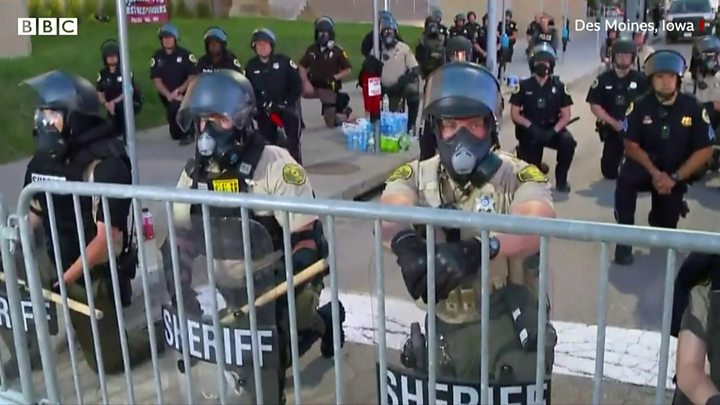President Donald Trump has threatened to send in the military to quell growing civil unrest in the US over the death of a black man in police custody.
He said if cities and states failed to control the protests and “defend their residents” he would deploy the army and “quickly solve the problem for them”.
Protests over the death of George Floyd have escalated over the past week.
Four police meanwhile have been shot and injured in Missouri, in what the force says is a continuing incident.
Hours earlier, in Washington DC, police cleared protesters from a nearby park with tear gas and rubber bullets as Mr Trump spoke at the White House.
The president then crossed the park and posed next to a damaged church, provoking widespread criticism from those who accused him of aggressively targeting the peaceful demonstrators in aid of a photo opportunity.
Meanwhile, dozens of major cities have imposed overnight curfews. New York City is under lockdown until 05:00 (09:00 GMT) on Tuesday and Washington DC has extended its curfew for another two nights.
In New York, the iconic department store Macy’s was broken into and a Nike store was looted, while other shop fronts and bank windows were smashed. Several people were arrested. Curfew will begin in the city at 20:00 (midnight GMT).
The protests began after a video showed Mr Floyd, 46, being arrested in Minneapolis on 25 May and a white police officer continuing to kneel on his neck even after he pleaded that he could not breathe.
The officer, Derek Chauvin, has been charged with third-degree murder and will appear in court next week. Three other police officers have been fired.
A post-mortem examination declared Mr Floyd’s death a homicide.
What did Trump say?
The president delivered a brief address from the White House Rose Garden, amid the sound of a nearby protest being dispersed.
Mr Trump said “all Americans were rightly sickened and revolted by the brutal death of George Floyd” but said his memory must not be “drowned out by an angry mob”.
He described the scenes of looting and violence in the capital on Sunday as “a total disgrace” before pledging to bolster the city’s defences.
“I’m dispatching thousands and thousands of heavily armed soldiers, military personnel and law enforcement officers to stop the rioting, looting, vandalism, assaults and the wanton destruction of property,” he said.
Mr Trump then turned his attention to the national protests, which he blamed on “professional anarchists” and the anti-fascist group Antifa. On Sunday, he said he intended to designate Antifa as a terrorist organisation.
He called on cities and states to deploy the National Guard, the reserve military force that can be called on to intervene in domestic emergencies, “in sufficient numbers that we dominate the streets”. About 16,000 of its troops have been deployed to deal with the unrest so far.
Mr Trump added: “If a city or state refuses to take the actions that are necessary… then I’ll deploy the United States military and quickly solve the problem for them.”
“I want the organisers of this terror to be on notice that you’ll face severe criminal penalties,” he said.
His comments were met with swift criticism from senior Democrats. Joe Biden, the party’s presumptive presidential candidate, said Mr Trump “[was] using the American military against the American people”.
An escalation of force?
Analysis By BBC’s Anthony Zurcher – North America Reporter
Throughout Monday, pressure grew on Donald Trump to take action to address the rising unrest in major cities across the US. As the sun set in Washington DC, in a hastily arranged Rose Garden address, the president outlined what that action would be.
Governors were warned that if they did not effectively secure property and safety on the streets, the president would cite a centuries-old law to dispatch the US Army on American soil. And in the District of Columbia, which is under federal authority, the president had already ordered the military to deploy in force.
Moments before the president spoke, promising he was on the side of peaceful protesters, those armed soldiers cleared out peaceful protesters from Lafayette Square, across the street from the White House.
It set the stage for the president to walk with his senior staff across the park to St John’s Church, which was lightly damaged in a fire set by rioters the previous evening – an important symbolic gesture or an unnecessary photo opportunity, depending on one’s perspective. Posing in front of the building with a Bible, he promised that America was “coming back strong” and “it won’t take long”.
There was no talk of police reforms or the root causes of the protests that began last week at any point in the evening’s proceedings. Instead, he said he was the “president of law and order” – a sign, it seems, that his solution to the ongoing crisis will be an escalation of force.

What’s the latest with the protests?
More than 75 cities have seen protests over what happened to George Floyd. Streets that only days ago were deserted because of the coronavirus pandemic have filled with demonstrators marching shoulder to shoulder.
Protests kicked off for another evening on Monday and more than 40 cities have imposed or extended their curfews.

Thousands of people marched in New York, just before the late-night curfew came into effect. Police made multiple arrests amid incidents of violence and shops being ransacked in Manhattan.
Smaller protests took place in other cities including Los Angeles and Oakland.
Elsewhere, the chief of Louisville Police in Kentucky was fired after police and National Guard shot into a crowd on Sunday night, killing the owner of a nearby business.



